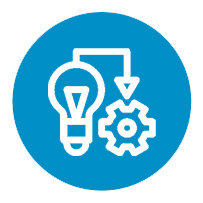Districts, cities and villages around the world seek to strengthen their economy, create jobs for their citizens and reduce inequalities. Through Local Economic Development (LED) frameworks, local authorities can strengthen their capacity to make optimal use of the existing and potential characteristics of the area. Achieving economic development is a big challenge in itself but ensuring that all citizens, including marginalised groups, benefit from economic development is an even bigger challenge. So how can local authorities design an effective and inclusive local economic development strategy? We have outlined five main steps for you.

Step 1: Identify and Convene LED Stakeholders
Local Economic Development is a participatory process. Therefore, any LED initiative will have to start with identifying the relevant stakeholders and getting them on board with the LED process. It is important to include all different stakeholders and specifically target those groups that are often not included in decision-making processes. Only with a complete representation of all citizens, and public and private actors, will the LED process become legitimate, meaningful, and have the authority to make effective change.
Crucially, this first phase involves deciding on the roles that your identified stakeholders will have in the process. Deciding on their roles is important, as it ensures that there is a clear way for them to cooperate and coordinate with one another. The challenge here is to facilitate collaboration between diverse actors who may have different positions and approaches on crucial topics.
 Step 2: Conduct a Local Economy Mapping and Analysis
Step 2: Conduct a Local Economy Mapping and Analysis
Once you have committed and organised a group of stakeholders, you will have to establish a thorough and shared understanding of your local economy. This means that you will have to conduct research and gather data in order to map and analyse the local economy. Once again, it is important that this analysis is holistic and includes all different segments of the economy. From here on, you have enough information to design an evidence-based LED process.
 Step 3: Formulate your LED Strategy
Step 3: Formulate your LED Strategy
Based on the mapping and analysis of your local economy, a LED strategy can be designed. This strategy sets out the shared vision and concrete interventions that all parties will undertake in order to promote local economic development. It is important that these interventions continue to be inclusive and do not exclusively focus on the needs of the majority.
 Step 4: LED Strategy Implementation
Step 4: LED Strategy Implementation
Once the strategic goals and priority interventions have been identified, effective arrangements must be put in place to support the implementation of the agreed actions. This means identifying actors to take lead responsibility, mobilising resources, creating necessary partnerships, as well as arranging effective project management, monitoring and reporting efforts.
This is often the most difficult stage of the LED process, and many strategies fail at this point. The types of activities included as part of LED strategies can vary enormously depending on the context. Therefore, identify the most critical elements for LED implementation in your context to ensure these core elements remain active.
 Step 5: Progress Monitoring and Impact Assessment
Step 5: Progress Monitoring and Impact Assessment
Once you have begun implementing your LED strategy, it is critical that you ensure that all actions are monitored and that the impact of the action is periodically evaluated to ensure that your objectives are being reached. This allows you to continuously identify opportunities for improvement to better reach your goals.
It is also important to have clear reporting arrangements in place so that stakeholders and local communities are aware of progress, remain engaged and can ask for accountability of the LED process.
Join our Local Economic Development Course! Interested in designing an effective and inclusive local economic development strategy? Sign up for one of our courses on Local Economic Development, either in its online format or face-to-face in The Hague (scholarship opportunities available for the latter).
Related courses
We offer a diversity of courses throughout the year. Here are several other courses you might like.

